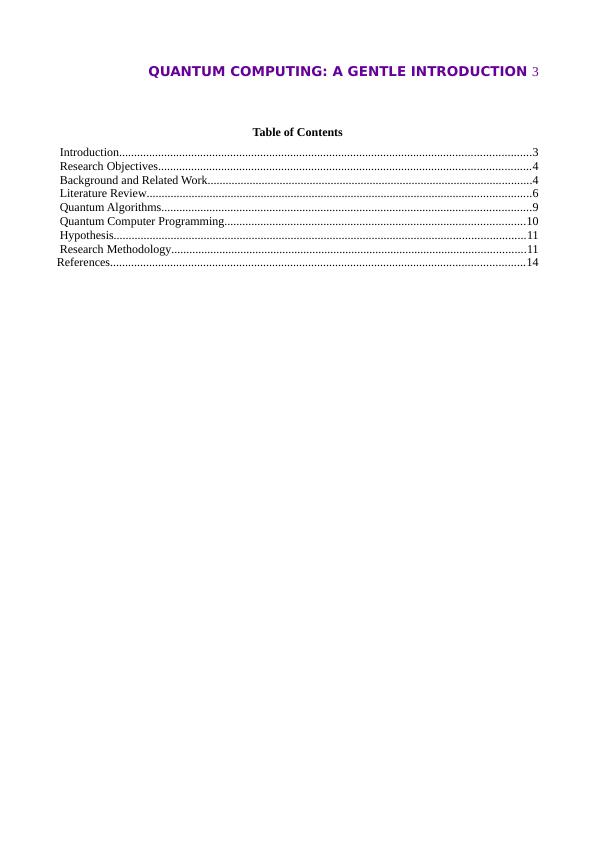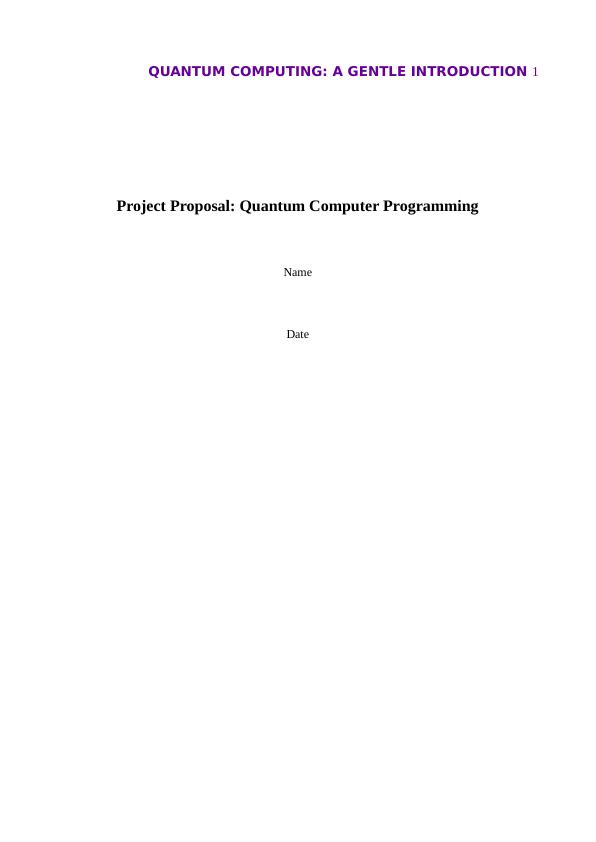Ask a question from expert
Quantum Computer Programming : Assignment
16 Pages3914 Words228 Views
Added on 2020-03-16
Quantum Computer Programming : Assignment
Added on 2020-03-16
BookmarkShareRelated Documents
QUANTUM COMPUTING: A GENTLE INTRODUCTION2AbstractQuantum computing is a promising field in the future in which computing power will be increased exponentially. While these computers are still not around, according to Moore’s Law, they should beexpected around 2023 to 2025, give or take 3 years. One aspect of quantum computing of immediate importance is how software to run on them will be programmed. This is because of the unique nature of quantum computers as they differ significantly in operation from the classical computers that are based n the Turing machines of the 1930s. Quantum computing uses a principle in quantum mechanics in which something can be in two places at the same time, and it is characterized by lack of determinism, contrary to the Newtonian concept of predictability. Quantumproperties use the destructive and constructive wave concepts for computing. Present languages are object oriented or imperative; their use on quantum computing is not possible yet the programming language for quantum computing must evolve from present languages like Python and JAVA to enable feasible commercial application. Most languages developed such as QRAM, qGCL, and QCL have challenges making them unsuitable for commercial programming for quantum computing. Using a semi-experimental confirmatory research design, this paper proposes a quantumprogramming language that will be simulated using classical computers and based on existing languages, but lacking the pitfalls of present quantum languages

QUANTUM COMPUTING: A GENTLE INTRODUCTION3Table of ContentsIntroduction.........................................................................................................................................3Research Objectives............................................................................................................................4Background and Related Work............................................................................................................4Literature Review................................................................................................................................6Quantum Algorithms...........................................................................................................................9Quantum Computer Programming....................................................................................................10Hypothesis.........................................................................................................................................11Research Methodology......................................................................................................................11References..........................................................................................................................................14

QUANTUM COMPUTING: A GENTLE INTRODUCTION4IntroductionThough still years away from becoming a commercially applicable reality, Quantum Computing is an interesting area that offers much promise in undertaking computations that are not at present feasible with the current generation of computers, the ‘classical computers’ (Rieffel & Polak, 2014). Quantum computers work in a way that is totally and radically different from classicalcomputers because qubits (quantum bits) can exist in a state of both one and zero, simultaneously such that a single qubit can store, and process N qubits of information. Based on the superposition state of having both one and zero, the information stored in N qubits can be computed as N qubits raised to the power on N classical bits (Meglicki, 2010). Quantum computing makes use of the quantum phenomena of mechanics such as entanglement and superposition to undertake operations on data and so this makes quantum computers markedly different from the classical computer that isbased on transistors (Raimond, Brune & Haroche, 2001). Classical computers require data encoding in binary form where the possible states are eitherzero or one, quantum computing allows for dual state. But just like the classical computer, quantum computers will have little value without the right software to be run on them hence the need to develop practical ways that these computers can be programmed as their arrival is eagerly awaited (Schlosshauer, 2010). Despite the idea of Quantum computers as pioneered by Yuri Marin and Paul Benioff in the early 1980s, not much consideration was placed on how to program these computers until the 1990s (Sarma, 2015). There are several proposals that have been made on programming quantum computers; however, many suffer from various flaws that render them impractical or highly expensive for application in typical environment for developing commercial software (McCaskey et al., 2017). The flaws with many proposals include;Lack of scalability: Some proposals work well for small code ‘snippets’ but becomes difficult to understand and manage them beyond this; examples include languages that require formal proofs and visual languages for programming. Foreign techniques: Techniques that are proposed for use are foreign to many commercial software developers, examples are functional languages Proprietary languages: There are many languages that can be used in quantum computing to date (almost 8500) yet very few can be used commercially and this poses a challenge since the majority of programming languages commercially used today have some unique features that enable their use commercially

End of preview
Want to access all the pages? Upload your documents or become a member.
Related Documents
Literature Review-Quantum Computinglg...
|12
|3319
|36
Digital Innovation: Quantum Computinglg...
|6
|1050
|52
The field of artificial intelligencelg...
|6
|1499
|61
Quantum Computing in Medical & Healthcare Sectorlg...
|11
|3575
|443
Analysis of Linux Kernel Vulnerabilities (PDF)lg...
|5
|5691
|163
Competency Demonstration Reportlg...
|4
|534
|300
